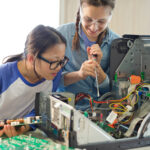COVID closed in-person classrooms and also gave a boost to cyberthreats to school district networks. As data security breaches–including ransomware attacks, phishing, and unauthorized disclosures–show no sign of slowing, K-12 IT leaders need to be ready.
IT teams understand how important cybersecurity measures are, but many struggle to pinpoint where to begin when their resources are limited.
Threats to K-12 education networks will never be eliminated, but there are strategies to successfully defend sensitive school district information. Want to learn more? Join a conversation with fellow edtech leaders and experts as they share best practices on both the technical aspects–software and services–and the human aspects–professional development and community education–of keeping your district networks safe and sound.
- Friday 5: Teacher stress - May 3, 2024
- Student success is impacted by issues outside of school, survey finds - May 1, 2024
- Friday 5: Virtual field trips - April 26, 2024
More from eSchool News
Student-centered everything: ClassVR in special education
Spaulding Academy & Family Services is a small, non-profit special education school and residential facility serving students with a wide range of abilities, including many who are on the autism spectrum.
Friday 5: Teacher stress
Educators have never had an easy job, but teacher stress and burnout are at chart-topping levels in schools across the nation.
Embracing tech and navigating change with people-centered leadership
How can leaders navigate evolving opportunities and challenges and drive positive impact, while keeping the interests of students and educators at the forefront?
Smarter Classrooms for Today and Tomorrow
In the ever-evolving landscape of education, technology can play a pivotal role in shaping the learning experience.
Student success is impacted by issues outside of school, survey finds
Educators believe the biggest obstacles to student success in school are tied to challenges outside the classroom, including mental health and behavior issues, according to a new report from McGraw Hill.
5 digital resources to inspire curiosity and engage students
Post-pandemic, educators in my district report that there has been a decline in student engagement. As educators, it is incumbent upon us to spark student’s curiosity so that they will engage with instruction.
Critical steps to help school districts combat ransomware attacks
School districts are one of the most vulnerable industries for a ransomware attack, particularly from foreign adversaries, according to Ann Neuberger, deputy national security adviser for cyber and emerging technology.
Empowering girls with STEM education to build tomorrow’s tech industry
All too often, female students are underrepresented in STEM classes. As a result, girls and young women have a hard time exploring the subjects and picturing themselves in related roles.
How a small school in Sierra Leone uses remote learning to offer high school
The American International School of Freetown in Sierra Leone (AISF) has 90 students between the ages of three and 19, seven teachers and a director–an all-encompassing administrative role.
Friday 5: Virtual field trips
While virtual field trips are not a new phenomenon, they gained popularity shortly before COVID due in part to their ability to expose students to places and experiences they may not otherwise access.










